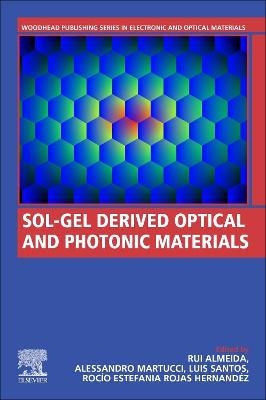
Sol-Gel Derived Optical and Photonic Materials
Woodhead Publishing (Verlag)
978-0-12-818019-8 (ISBN)
There is no book available yet which focuses in particular on optical and photonic sol-gel derived materials. This is what makes this book unique at this point for those especially or exclusively interested in optical and photonic functional materials and applications. This book represents an important tool to update scientists and engineers with recent advances in the rapidly evolving field of optical and photonic materials, components and devices. Our target audience are those working in materials science, physics, engineering and chemistry disciplines, in particular academics and researchers working in advanced optical/photonic processing technologies, research and development engineers in high technology industries and research project leaders. This book will also be an essential tool for graduate students pursuing a PhD or even a Master’s degree.
Dr. Rui M. Almeida is a Portuguese Materials Scientist. He received his Ph.D. degree in Materials Engineering from University of California, Los Angeles, USA, in 1980. He has started his research and teaching activity at Instituto Superior Técnico (IST), University of Lisboa, Portugal, in several fields of materials science and engineering. From 1990, he is full professor of Materials Engineering. From 1992 until 2010, he was director of ICEMS (Institute of Science and Engineering of Materials and Surfaces), a research organization affiliated with IST. He has published over two hundred scientific papers in peer-reviewed international journals in the broad fields of materials science, physics and chemistry, he has co-authored close to twenty book chapters and edited four books. He is editorial board member of several materials science international journals and associate editor of the International Journal of Applied Glass Science. His most recent interests relate to the optical and photonic properties of glasses, thin films and sol-gel derived materials, including the application of frequency conversion materials to solar cells and solid state lighting. He is Fellow of the American Ceramic Society (USA), the Society of Glass Technology (UK) and the International Sol-Gel Society. Dr. A. Martucci received his Ph.D. degree in Materials Engineering from University of Bologna Italy, in 1997. He has started his research and teaching activity at University of Padova, Italy, in the field of glass, ceramics and nanocomposite films obtained by wet chemistry processing for photonic, optical and gas sensor applications. From 2019, he is full professor of Materials Science Engineering at Padova University. He has published over 250 scientific papers in peer-reviewed international journals. He is editorial board member of several materials science international journals He is Fellow of the American Ceramic Society (USA) and the International Sol-Gel Society. Luis Santos received the degree of Doctor of Engineering Science in Materials Science from Instituto Superior Técnico in 1996. He is Assistant Professor in the Department of Chemical Engineering at Instituto Superior Técnico, University of Lisbon and a researcher in the Centre for Structural Chemistry (CQE) In academia, he has developed and taught both graduate and undergraduate courses in materials science specializing in characterization of materials, glasses and ceramics. He has supervised 2 post-docs, 4 PhD students and 10 Master students. He has published over 70 papers and 1 book chapter. He has been involved in more than 10 R&D projects, three of them as Principal Investigator. Currently he is involved in the project “Photonic crystal-assisted frequency conversion phosphor layers for energy applications, where photonic crystals thin films are prepared and used to assist the up-conversion and down-conversion processes. This is expected to improve the conversion efficiency of solar cells. Dr. Rojas has more than 7 year’s research experience, five of which are in the ceramic research field during their PhD (4 years) and as Post-Doctoral Researcher (1 year) in the Ceramics for Smart Systems group, at the Instituto de Cerámica y Vidrio, CSIC, Spain. Now, Dr. Rojas holds a position as Post-Doctoral Researcher (1 year and 8 months ago) in Glasses and Thin Films for Nanophotonics and Integrated Optics Group belonging to Depart. Eng. Química, CQE, at Instituto Superior Técnico, Lisboa as part of research team in the framework of COFRE project (Photonic crystal-assisted frequency conversion phosphor layers for energy applications) funded by FCT. In this latter position, Dr. Rojas has focused on sol-gel synthesis and optical characterization of down and up-conversion materials (amorphous and nanocrystalline) including bulk form as well as thin films.
1. Introduction
2. Sol–gel derived anti-reflective coatings for high fluence lasers
3. TiO2 coatings prepared by sol-gel and electrochemical methodologies
4. One-dimensional multilayer photonic crystals
5. Design and implementation of 2-D photonic crystals using sol–gel materials
6. 3D-photonic crystals: Opal structures
7. Photovoltaic spectral conversion materials: The role of sol–gel processing
8. Hybrid materials for patterning and waveguiding
9. Semiconductor quantum dot-doped sol–gel materials
10. Lanthanide-doped oxyfluoride transparent glass–ceramics prepared by sol–gel
11. Sol–gel derived phosphors for optical applications
12. Optical gas sensors
13. Sol–Gel materials for optical and electrooptical applications
14. Sol–gel materials for optical fibers
15. Multifunctional magnetic, optical and electrical nanomaterials processed by sol–gel method
| Erscheinungsdatum | 15.01.2021 |
|---|---|
| Reihe/Serie | Woodhead Publishing Series in Electronic and Optical Materials |
| Sprache | englisch |
| Maße | 152 x 229 mm |
| Gewicht | 640 g |
| Themenwelt | Naturwissenschaften ► Chemie ► Physikalische Chemie |
| Technik ► Elektrotechnik / Energietechnik | |
| Technik ► Maschinenbau | |
| ISBN-10 | 0-12-818019-6 / 0128180196 |
| ISBN-13 | 978-0-12-818019-8 / 9780128180198 |
| Zustand | Neuware |
| Haben Sie eine Frage zum Produkt? |
aus dem Bereich


